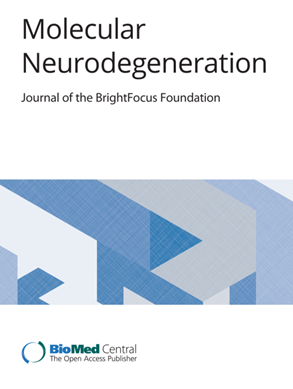针对tau片段的免疫治疗减少AD病理,改善突触功能和认知
IF 17.5
1区 医学
Q1 NEUROSCIENCES
引用次数: 0
摘要
天冬酰胺内肽酶(AEP)通过在残基N368处切割Tau蛋白,加速其过度磷酸化和聚集,参与阿尔茨海默病(AD)的发病机制。脑脊液(CSF)中Tau N368/t-Tau比值与已建立的生物标志物(p-Tau 181/217)相比,可作为与AD患者Tau病理和突触功能障碍相关的优越生物标志物,突出其诊断和治疗潜力。我们在两种小鼠模型:Tau P301S (Tau病)和3xTg (AD伴a β/ Tau病理)中评估了Tau n368特异性抗体的治疗效果。我们进行了慢性腹腔注射,以评估其对tau聚集、突触完整性和认知功能的影响。我们分析了3xTg小鼠的神经病理变化、突触可塑性(通过电生理)和行为结果,以及Aβ病理和神经炎症。在两种模型中,抗Tau N368抗体显著减少了由过度磷酸化/截断的Tau形成的神经原纤维缠结(nft)。清除Tau恢复BDNF/TrkB神经营养信号,改善突触可塑性,减轻认知缺陷。在3xTg小鼠中,这种治疗还减少了Aβ沉积和神经炎症,从而增强了学习和记忆。值得注意的是,该抗体在缓解tau和a β病理方面的有效性表明这些途径之间存在潜在的相互作用。通过免疫治疗靶向Tau N368可减轻AD模型中Tau驱动的神经退行性变,恢复突触功能,并改善伴随的Aβ病理。我们的研究结果证实,Tau N368是一种特殊的生物标志物和有希望的治疗靶点,通过解决Tau聚集及其下游效应来破坏AD的进展。本文章由计算机程序翻译,如有差异,请以英文原文为准。
Immunotherapy against tau fragment diminishes AD pathology, improving synaptic function and cognition
Asparagine endopeptidase (AEP) is implicated in the pathogenesis of Alzheimer’s disease (AD) by cleaving Tau at residue N368, accelerating its hyperphosphorylation and aggregation. The Tau N368/t-Tau ratio in cerebrospinal fluid (CSF) serves as a superior biomarker compared to established biomarkers (p-Tau 181/217) for correlating with tau pathology and synaptic dysfunction in patients with AD, highlighting its diagnostic and therapeutic potential. We evaluated the therapeutic efficacy of a Tau N368-specific antibody in two mouse models: Tau P301S (tauopathy) and 3xTg (AD with Aβ/tau pathology). We conducted chronic intraperitoneal administration of the antibody to evaluate its effects on tau aggregation, synaptic integrity, and cognitive function. Neuropathological changes, synaptic plasticity (through electrophysiology), and behavioral outcomes were analyzed alongside Aβ pathology and neuroinflammation in 3xTg mice. Treatment with the anti-Tau N368 antibody significantly diminished neurofibrillary tangles (NFTs) formed of hyperphosphorylated/truncated Tau in both models. Clearance of Tau restored BDNF/TrkB neurotrophic signaling, improved synaptic plasticity, and alleviated cognitive deficits. In 3xTg mice, this treatment also reduced Aβ deposition and neuroinflammation, resulting in enhanced learning and memory. Notably, the antibody’s effectiveness in alleviating both tau and Aβ pathologies indicates a potential interaction between these pathways. Targeting Tau N368 through immunotherapy alleviates tau-driven neurodegeneration, restores synaptic function, and improves accompanying Aβ pathology in AD models. Our results confirmed that Tau N368 is an exceptional biomarker and a promising therapeutic target, disrupting AD progression by addressing tau aggregation and its downstream effects.
求助全文
通过发布文献求助,成功后即可免费获取论文全文。
去求助
来源期刊

Molecular Neurodegeneration
医学-神经科学
CiteScore
23.00
自引率
4.60%
发文量
78
审稿时长
6-12 weeks
期刊介绍:
Molecular Neurodegeneration, an open-access, peer-reviewed journal, comprehensively covers neurodegeneration research at the molecular and cellular levels.
Neurodegenerative diseases, such as Alzheimer's, Parkinson's, Huntington's, and prion diseases, fall under its purview. These disorders, often linked to advanced aging and characterized by varying degrees of dementia, pose a significant public health concern with the growing aging population. Recent strides in understanding the molecular and cellular mechanisms of these neurodegenerative disorders offer valuable insights into their pathogenesis.
 求助内容:
求助内容: 应助结果提醒方式:
应助结果提醒方式:


